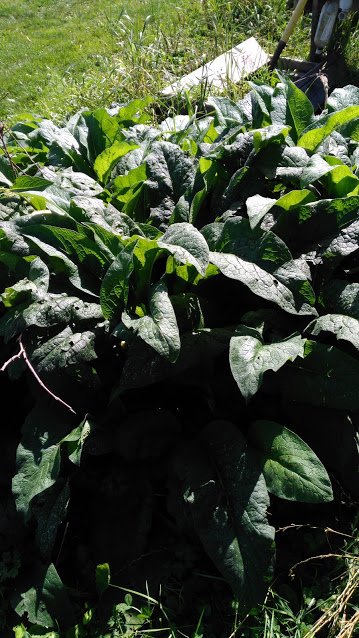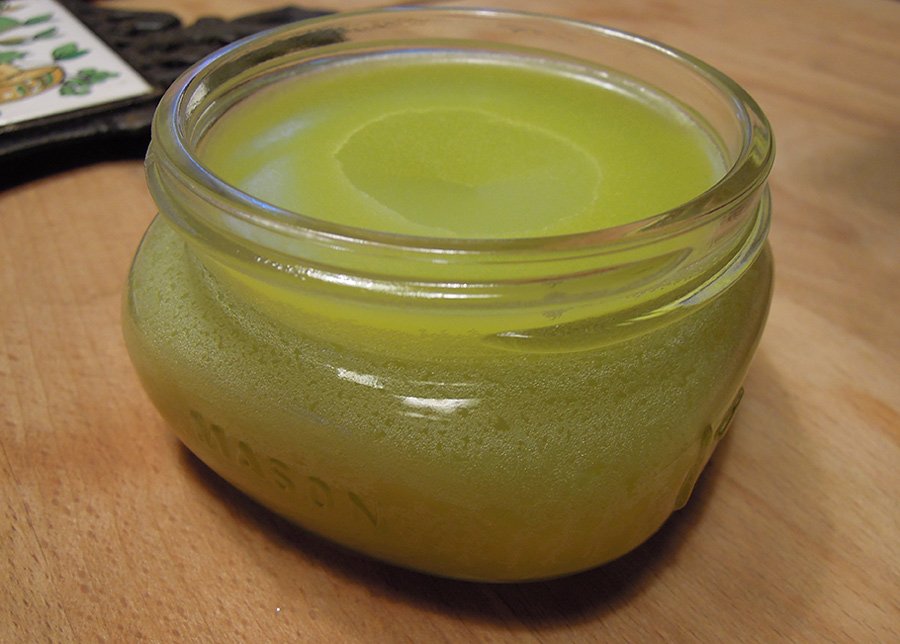Why buy fertilizer when you can grow your own? We’re growing fertilizer in garden beds, around fruit trees, and even more along the fence. What is the fertilizer we’re growing?
It’s comfrey. Specifically, it’s the bocking 14 cultivar of Russian comfrey.
Comfrey is a fast-growing herbaceous, perennial from the borage family that is hardy in zones 3 through 9.
It grows vigorously and can take over your garden if you’re not careful, but if you chop and use it several times per year it can be controlled. If you have animals like chickens, pigs, goats or rabbits you can feed it to them and they will keep it in check while spreading its nutrients around.
The bocking 14 cultivar that we grow is not self-seeding, which makes managing it much easier. When we want more comfrey plants, we just propagate them by root cuttings, which is a very simple process.
Here in zone 8, comfrey grows best in full sun but does well in partial shade as well. Comfrey has a deep and extensive tuberous root system that enables it to mine nutrients from the subsoil and store them in its leaves and stems.
This ability is important because over time nutrients in the topsoil leach down to the subsoil where it’s difficult for veggies to obtain them.
Comfrey cycles the nutrients back up to the topsoil by first accumulating them in its leaves and then releasing the nutrients back into the topsoil when its leaves and stems decay.
What Nutrients Does Comfrey Accumulate?
Researchers in British Columbia found that air-dried comfrey leaves have an NPK of 1.8, 0.5, 5.3.
That’s a good amount of nitrogen and phosphorus, but the amount of potassium is especially impressive. In addition to nitrogen, phosphorus, and potassium, comfrey also accumulates magnesium, calcium, iron, and silicon.
These nutrients get added to the soil and taken up by the plants growing there and if those plants are food crops then these minerals will get absorbed by the plants and those eating those plants.
How To Make Fertilizer With Comfrey
My favorite strategy to put these nutrients to work in the garden is to use the comfrey as mulch. I just chop the comfrey and then drop it on the soil where I want to supply the nutrients.
I usually wear gloves when doing this, because comfrey is a little prickly and can irritate the skin. After chopping and dropping, it will take some time for the nutrients to become plant available, so I often use this approach when preparing a bed for planting.
I also mulch around existing plants to provide a slow release of nutrients. Of course, the comfrey mulch will provide all the other benefits of mulch as well, including improved water retention, decreased erosion, increased organic matter, moderated soil temperatures, and larger worm populations.
Some sources say that it’s best to chop and drop comfrey just before it flowers because that’s when its nutrients are at their peak. I do follow this guideline with some of my plants, but I also let some flower because the flowers attract bees and other beneficial insects to the garden. You’d think with the amount of chopping I’m doing today that I’d be out of comfrey for the rest of the season, but comfrey grows very fast.

The earthworms and composting worms in the bed no doubt helped speed up the process as they love to munch on decaying comfrey.
My second favorite approach to using comfrey in the garden is to make comfrey smoothies, which are great for getting nutrients to the plants a little more quickly.
I just chop up some leaves into small pieces with a chipper and blend them in water.
This is the approach I took recently when feeding my apples trees after transplanting them. For the most part, I only make comfrey smoothies when I really think a plant needs a quick boost of comfrey goodness. Otherwise, I rely on the chop and drop.
I should probably also note that the comfrey smoothies are great for plants but not meant for human consumption, as comfrey is toxic to the liver.
My third favorite strategy for using comfrey in the garden is to add it to compost. In fact, because comfrey is rich in nitrogen and decomposes quickly, it’s a great compost activator. It really helps heat up a pile when combined with the right mix of brown ingredients. I typically only add comfrey to our compost piles in the fall, however, when green compost ingredients are in short supply and most of the garden beds are planted with cover crops.
The last way we’ve put comfrey to work in the garden is with comfrey tea. Comfrey tea is usually made by one of two processes: either placing comfrey leaves in a bucket of water for 3 to 4 weeks to decompose, or by packing a bucket with comfrey leaves, placing a weight on top, and waiting for the comfrey to decompose into a greenish black sludge, which is then diluted with water before being applied to the garden.

We’ve used comfrey tea in the past with success, but it does have a very strong odor, which is something to take into consideration if you have neighbors close.
So, if you’re interested in a low cost, perpetual, and highly sustainable fertilizer that you can grow yourself, you might want to consider growing comfrey. It’s easy to grow, easy to propagate, and easy to put to work in your garden.
If that wasn't enough for you to love adding comfrey to your garden, comfrey also contains allantoin which helps promote rapid cell growth and helps with healing wounds.
Comfrey is used as a tea for upset stomach, ulcers, heavy menstrual periods, diarrhea, bloody urine, persistent cough, painful breathing, bronchitis, cancer, and chest pain . It is also used as a gargle for gum disease and sore throat.
Comfrey is applied to the skin for ulcers, wounds, joint inflammation, bruises, rheumatoid arthritis, swollen veins, gout, and fractures.
I have seen it heal burns and deep cuts without leaving a scar, almost like magic. All we did was grind up the leaves into a pulp and applied it to the wound directly. Then wrapped it in bandages making sure to keep the moist plant material in contact with the wound.
Changed the bandages periodically and applied fresh, leaf pulp and it healed the skin as good as new.
It can also be made into a skin lotion or salve very easily.
Comfrey Salve Recipe

Ingredients
Comfrey leaf
Plantain Leaf
Yarrow Flower (white variety)
Echinacea Leaf
Echinacea Root
Virgin coconut oil or olive oil
Beeswax, preferably organic (optional)
Dutch oven or crockpot
Mason jar with non-BPA lid
Instructions
Fill mason jar two-thirds full of the herb mix above in roughly similar amounts.
Gently liquify the oil if necessary (coconut oil liquifies at 76 F/24 C).
Add the oil until it fills the mason jar. Leave one inch at the top. Screw on the lid tightly.
Place an old rag in the bottom of a dutch oven or crockpot (I like this one) and place mason jar on top.
Fill the crockpot with water until it is filled to one inch below the top of the jar.
Keep on low heat (be very careful not to boil the oil as it needs to be hot to infuse the herbs, but never boiling) for 72 hours.
As water evaporates, add more water to maintain the proper level.
Enjoy … your kitchen will smell lovely as the herbs release their medicinal properties into the oil.
After 3 days, the oil will be darkened and ready to use. Strain out the herbs using a cheesecloth or an old white cotton shirt.
The comfrey infused oil may now be used as is for a wonderful massage oil.
To transform the oil into a salve, you need to add beeswax.
Depending how much oil you have once the herbs are strained out, add 3 ounces/85 grams of grated beeswax for every cup of oil.
Warm the mixture together in a medium sized pot on low heat until the wax is melted.
Stir gently to distribute the wax evenly.
Add a drop of Vitamin E oil or wheat germ oil per 1 ounce/28 grams of oil if you desire additional natural preservative effect beyond what the rosemary provides.
While the salve is still warm, pour into your containers of choice (I prefer these).
Let the containers sit until the oil hardens. Screw on the lids and be sure to label and date each one. credit


